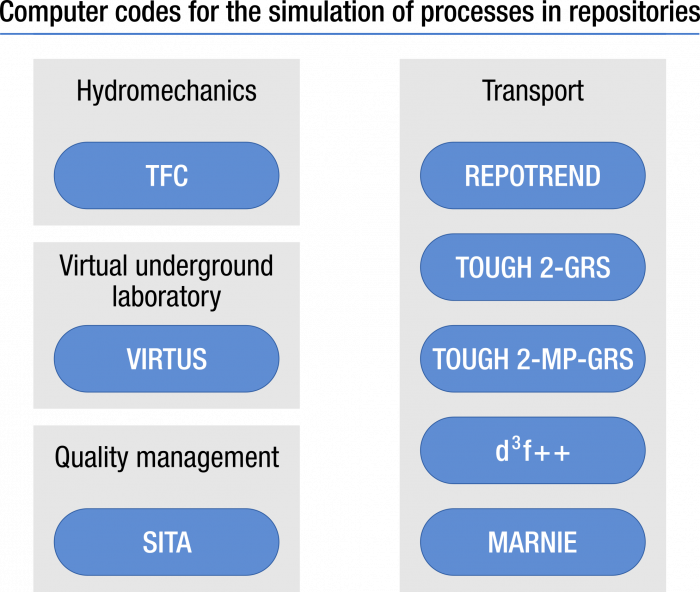Repository Research Codes
The codes describe e.g. the movement of groundwater or gases and the transport of contaminants, which may be released from the repository.
The modelling is based on the results of experimental research in the GRS’ Geoscientific Laboratory or in international underground laboratories. By comparing the computational and analysis results, the codes are continuously improved and further developed.
Areas of application
The computer codes are used i.a. for
- the safety analyses and assessment of repositories,
- the development and examination of repository concepts,
- the modelling of repository-related processes on the basis of analyses or the scaling of the models to real conditions in a repository
- research issues relating to the site selection or
- comparing different types of host rock
1. Hydromechanically coupled codes: TFC
Hydromechanically coupled codes allow simultaneous analysis of the various thermal, hydraulic, mechanical and chemical processes in the repository, thus demonstrating interactions. GRS has developed the TFC code for the calculation of such processes.
2. Codes for the modelling of the transport: TOUGH2-GRS, RepoTREND, d3f++, MARNIE
Transport modelling codes simulate the movement of liquids and gases and the transport of contaminants or heat based on these movements. This group includes the GRS code TOUGH2-GRS, which can be used to calculate multidimensional thermal and hydraulic processes. This allows a better understanding of the distribution of heat as well as the movement of groundwater, gases or radionuclides through the subsoil. The TOUGH-MP-GRS version allows for even faster calculations, as multiple processors are running simultaneously.
The RepoTREND program package was developed as an integrated computer code that provides a variety of modules for the calculation of the radionuclide transport in the repository zone (e.g. underground structure), in the host rock, in the overburden and in the ground water as well as the release of radionuclides into the biosphere, thus enabling the calculation of the radiological consequences.
The GRS d3f++ program enables the modelling of density-driven ground water flow in hydrogeologically complex two- or three-dimensional areas and over long periods of time. The simulation of the transport of contaminants takes into account the processes relevant for disposal, e.g. radioactive decay and sorption processes. For the related simulation in salt rock formations, GRS has developed the computer code MARNIE.
3. Computer codes for quality management
Beside the investigation of the repository phenomena, the testing and validation of the codes is an essential part of the GRS’s repository research. The GRS computer code SITA enables the testing of various codes on the basis of test cases. Thereby, it is possible to compare the computational results of a further developed code version with those of the previous version in order to detect possible inconsistencies and program errors. Since SITA is an automated test case execution and evaluation tool, the testing for program errors can be carried out more often, which is particularly important in code development.
4. VIRTUS – the virtual underground laboratory
Within the framework of the VIRTUS project, together with other research institutions, GRS has developed the world’s first virtual underground research laboratory. Here, researchers are able to carry out virtual experiments in detailed 3D-models of repository mines in real geological formations. The software is providing more comprehensible and transparent information to the public on the issue of disposal.
